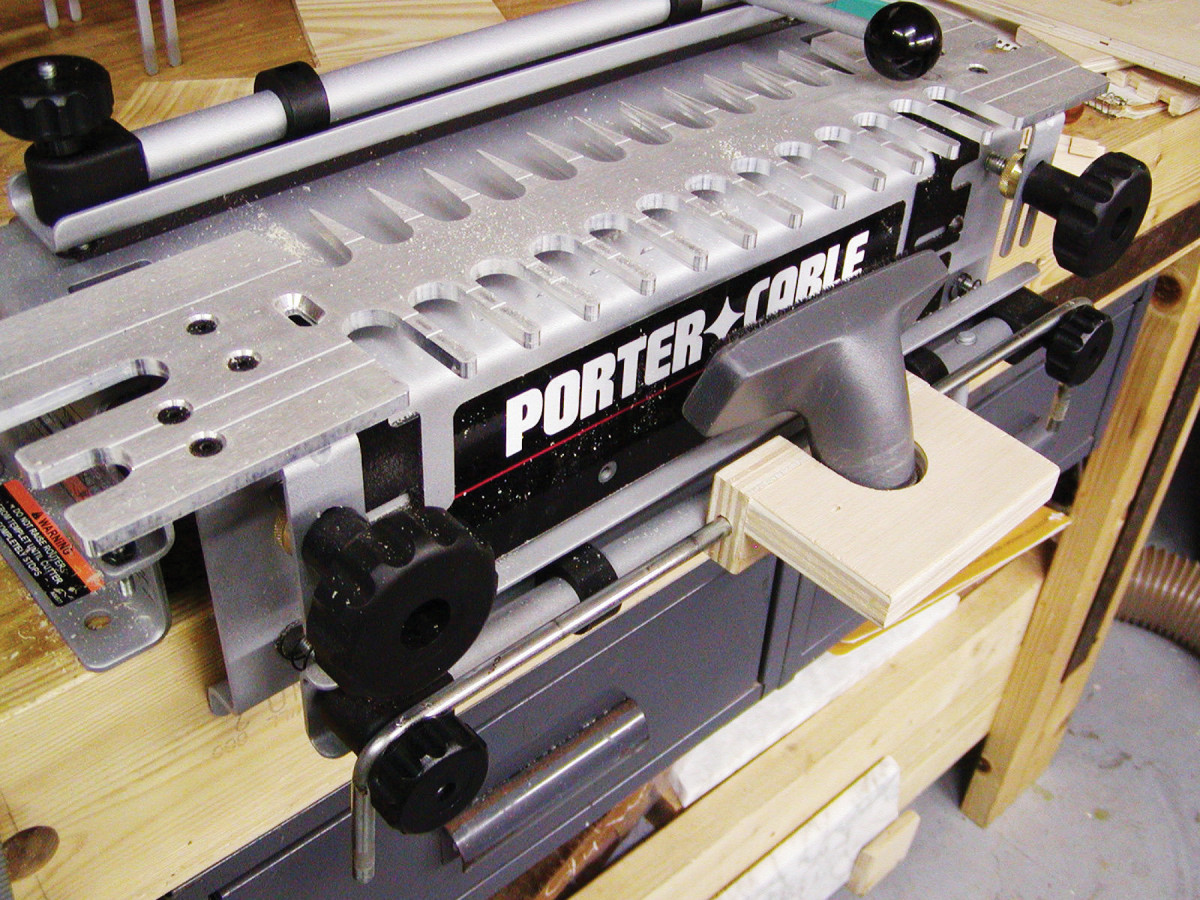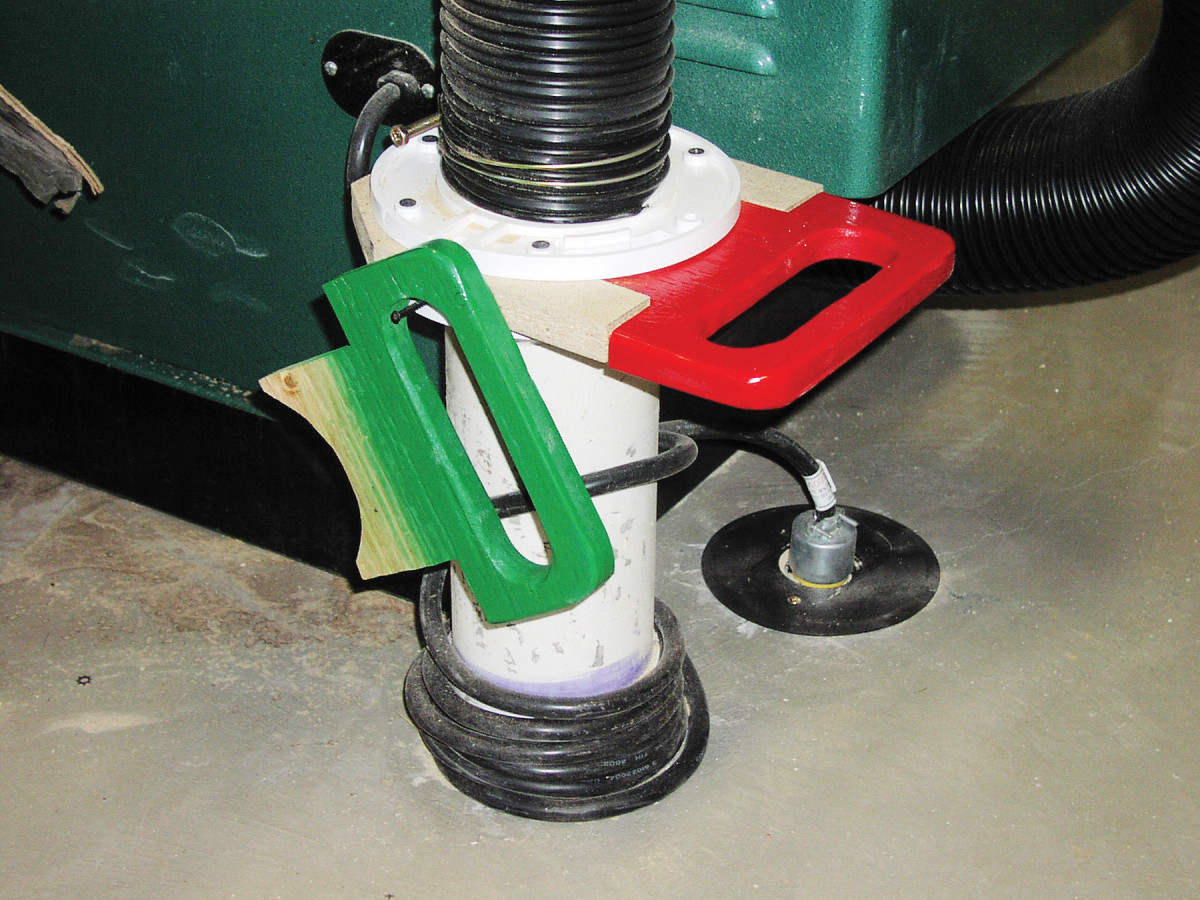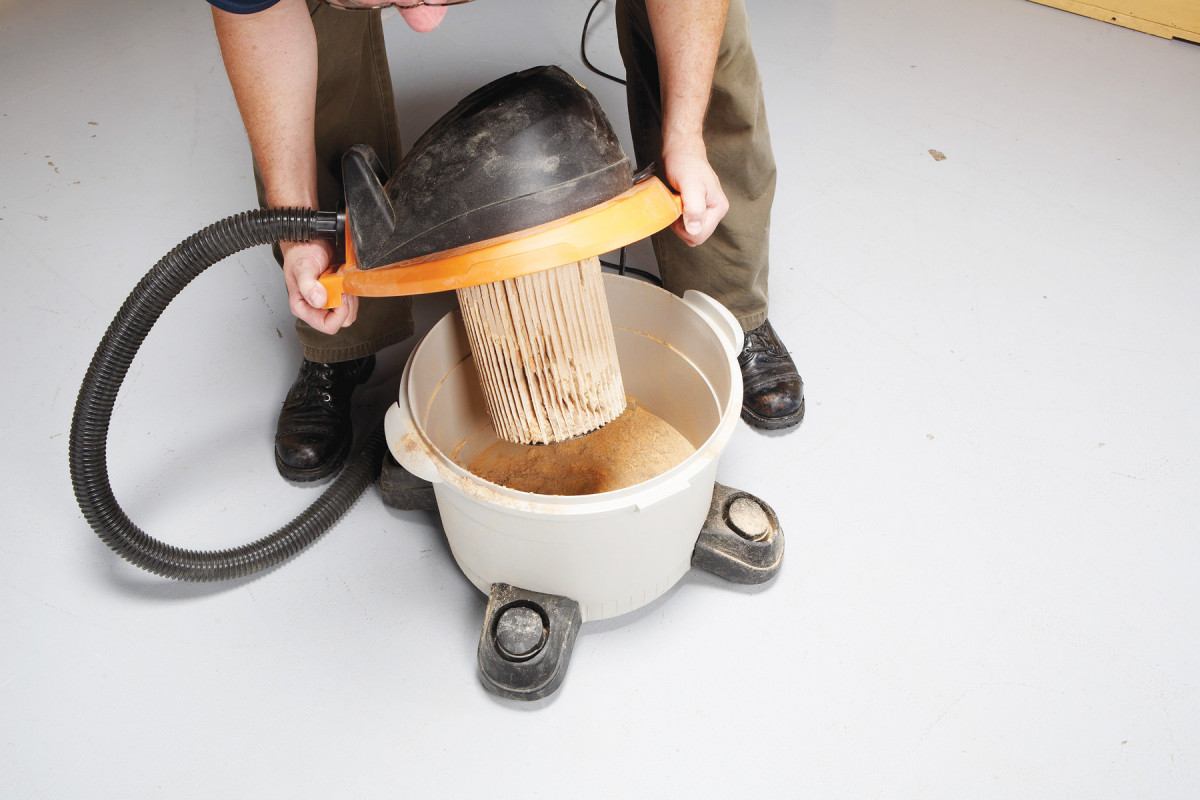We may receive a commission when you use our affiliate links. However, this does not impact our recommendations.
 Practical solutions for a cleaner shop
Practical solutions for a cleaner shop
Vacuum-Assisted Bench
 I got tired of hooking my bench tools to my shop vac. Now I simply plug their dust collection hoses into the bench. I drilled and routed a hole in the bench to house the 2- 1/2-in. PVC pipe and hexagonal 2-1/2-in.-to-1- 1/4in. reducer that I bought at a home center.
I got tired of hooking my bench tools to my shop vac. Now I simply plug their dust collection hoses into the bench. I drilled and routed a hole in the bench to house the 2- 1/2-in. PVC pipe and hexagonal 2-1/2-in.-to-1- 1/4in. reducer that I bought at a home center.
 My shop vac’s hose fits the pipe underneath the bench. Above the bench, I use a tapered adaptor to attach my tool hoses. This set-up also makes it easy to keep my benchtop clean. I just turn on the vac and sweep all the crud into the hole. -Miles Clay
My shop vac’s hose fits the pipe underneath the bench. Above the bench, I use a tapered adaptor to attach my tool hoses. This set-up also makes it easy to keep my benchtop clean. I just turn on the vac and sweep all the crud into the hole. -Miles Clay
User-Friendly Dust Hood
 The mounting bracket that came with the dust hood I purchased for my mini lathe was tough to adjust and difficult to remove. So I discarded it and designed my own, using a pair of 3/4-in. by 2-in. by 10-in. oak rails and 1/2-in. rare earth magnets. I fastened the magnet cups to the rails and then installed the magnets, positioned to rest on my lathe’s bed.
The mounting bracket that came with the dust hood I purchased for my mini lathe was tough to adjust and difficult to remove. So I discarded it and designed my own, using a pair of 3/4-in. by 2-in. by 10-in. oak rails and 1/2-in. rare earth magnets. I fastened the magnet cups to the rails and then installed the magnets, positioned to rest on my lathe’s bed.
 I drilled pilot holes before attaching the dust hood with sheet metal screws. I spaced the rails as widely as the hood allowed, to provide clearance for adjusting the tool rest. -Scott Muth
I drilled pilot holes before attaching the dust hood with sheet metal screws. I spaced the rails as widely as the hood allowed, to provide clearance for adjusting the tool rest. -Scott Muth
Hose Clamp Jig
 This T-track jig makes it easy to precisely position a dust collection hose on a router table or any other tool equipped with Ttrack. To make the jig, I cut a 1/2-in.-wide groove in a piece of 1/2-in. by 3-in.-square plywood to house a 1-1/2-in.-dia. reusable cable clamp.
This T-track jig makes it easy to precisely position a dust collection hose on a router table or any other tool equipped with Ttrack. To make the jig, I cut a 1/2-in.-wide groove in a piece of 1/2-in. by 3-in.-square plywood to house a 1-1/2-in.-dia. reusable cable clamp.
 The groove keeps the clamp from twisting. I attached the clamp with a 6- 32 by 1/2-in. flathead machine screw. I recessed the nut in the bottom of the plywood, so it wouldn’t interfere with the Tslot. Then I installed a 1/4”-20 by 1-in. hex head bolt to slide the jig in the T-track and a wing nut to lock it in position. -Mark Thiel
The groove keeps the clamp from twisting. I attached the clamp with a 6- 32 by 1/2-in. flathead machine screw. I recessed the nut in the bottom of the plywood, so it wouldn’t interfere with the Tslot. Then I installed a 1/4”-20 by 1-in. hex head bolt to slide the jig in the T-track and a wing nut to lock it in position. -Mark Thiel
Dust Collector Bags
 My 1-hp. dust collector came with a plastic bag to collect the sawdust. The idea is to remove the bag when it’s full, tie it off and dispose of it. Unfortunately, replacement bags cost $6 apiece. So I decided to substitute a heavy-duty trash bag. These bags cost quite a bit less, about 45 cents apiece (I’m using Hefty Ultra Flex 30-gal. bags). However, they’re made from thinner plastic than the factory bags, so I’m careful not to suck up nails or other sharp objects that might cause a puncture. The bags are a little too wide, so I use tape to hold them in position while I lock the containment ring. The ring holds the bags firmly in place on the collector. When a bag gets full, I remove it, pull the drawstring closed, and set it out for the trash man. -Ira Penn
My 1-hp. dust collector came with a plastic bag to collect the sawdust. The idea is to remove the bag when it’s full, tie it off and dispose of it. Unfortunately, replacement bags cost $6 apiece. So I decided to substitute a heavy-duty trash bag. These bags cost quite a bit less, about 45 cents apiece (I’m using Hefty Ultra Flex 30-gal. bags). However, they’re made from thinner plastic than the factory bags, so I’m careful not to suck up nails or other sharp objects that might cause a puncture. The bags are a little too wide, so I use tape to hold them in position while I lock the containment ring. The ring holds the bags firmly in place on the collector. When a bag gets full, I remove it, pull the drawstring closed, and set it out for the trash man. -Ira Penn
Dovetail Jig Dust Collection
 I created this device to capture dust and chips when I rout dovetails. The upholstery brush slides on the rod, so I can position it wherever it’s needed. After gluing together an L-shaped plywood assembly, I cut a 1-1/2-in.-dia. hole in the face and drilled a 1/4-in.-dia. hole through the end. I ran a length of 1/4-in. steel rod through the assembly and then bent both ends to fit around the lower knobs on my dovetail jig. Then I installed a common vacuum cleaner upholstery brush. The brush rests just below the jig’s fingers, so it catches chips as they come off the router. -Mark Thiel
I created this device to capture dust and chips when I rout dovetails. The upholstery brush slides on the rod, so I can position it wherever it’s needed. After gluing together an L-shaped plywood assembly, I cut a 1-1/2-in.-dia. hole in the face and drilled a 1/4-in.-dia. hole through the end. I ran a length of 1/4-in. steel rod through the assembly and then bent both ends to fit around the lower knobs on my dovetail jig. Then I installed a common vacuum cleaner upholstery brush. The brush rests just below the jig’s fingers, so it catches chips as they come off the router. -Mark Thiel
Blast Gates for PVS Ductwork
 For dust collection, my shop has PVC pipe buried in the dirt under the concrete floor. Compared to other types of ductwork, PVC is economical. I also decided to make my own blast gates.
For dust collection, my shop has PVC pipe buried in the dirt under the concrete floor. Compared to other types of ductwork, PVC is economical. I also decided to make my own blast gates.
 They use a pair of PVC water closet flanges. I cut a U-shaped opening in a piece of 3/4-in. MDF and sandwiched it between the flanges. Then I cut blast gates from 3/4-in. plywood, one to block the air and one to allow it to flow. As 3/4-in. plywood is thinner than 3/4-in. MDF, the handles slide easily.
They use a pair of PVC water closet flanges. I cut a U-shaped opening in a piece of 3/4-in. MDF and sandwiched it between the flanges. Then I cut blast gates from 3/4-in. plywood, one to block the air and one to allow it to flow. As 3/4-in. plywood is thinner than 3/4-in. MDF, the handles slide easily.
 I painted them red and green to indicate function. I mounted the assembly on the floor pipe and attached the flexible hose. Now a quick glance tells me if the gate is open or closed. -Ray Merrell
I painted them red and green to indicate function. I mounted the assembly on the floor pipe and attached the flexible hose. Now a quick glance tells me if the gate is open or closed. -Ray Merrell
Chip-Free Mortises
 I use a low-tech set-up to clear chips when I’m mortising. I simply tape my shop vac’s hose on top of an old can that’s filled with sand). A one-quart can puts the hose at the perfect height to remove chips directly from the bit’s ejection port. The result is a cool-running bit and a chip-free mortise. -Jeff Herman
I use a low-tech set-up to clear chips when I’m mortising. I simply tape my shop vac’s hose on top of an old can that’s filled with sand). A one-quart can puts the hose at the perfect height to remove chips directly from the bit’s ejection port. The result is a cool-running bit and a chip-free mortise. -Jeff Herman
Shop-Made Wye Fitting

When I got my Cyclone dust collector, I decided to install spiral ductwork. But I was shocked when I saw the cost of the wye fittings. Then I noticed 45-degree boot saddles, used to retrofit existing ductwork. I did the math and figured I could make my own wye fittings for less than half the cost of factory-made. I positioned the boot saddle where I wanted it to go on a straight run of spiral pipe and traced the inside opening, where the hole is to be cut out. After cutting the hole, I pop-riveted the boot saddle in place and used foil duct tape to seal it up. -Rob Mousel
Planer Stop-Leak
 The first time I used my new benchtop planer, its dust collection assembly leaked like a sieve. The snap-in-place exhaust port didn’t seat properly. Attaching the dust collection hose just made things worse, because of the added weight.
The first time I used my new benchtop planer, its dust collection assembly leaked like a sieve. The snap-in-place exhaust port didn’t seat properly. Attaching the dust collection hose just made things worse, because of the added weight.
 Removing the exhaust port revealed more gaps between the dust collection’s intake assembly. To solve the problem, I removed the intake assembly and caulked all the mating surfaces. To seat the exhaust port firmly, while keeping it easy to install and remove, I tapped a pair of holes into the main casting and installed thumb screws. –Mark Thiel
Removing the exhaust port revealed more gaps between the dust collection’s intake assembly. To solve the problem, I removed the intake assembly and caulked all the mating surfaces. To seat the exhaust port firmly, while keeping it easy to install and remove, I tapped a pair of holes into the main casting and installed thumb screws. –Mark Thiel
Panty-Hosed Vac
 For years, my shop vac’s best friend has been a discarded pair of panty hose. I cut a section from the wider part of the leg and slip it over the vac’s pleated filter. The panty hose acts as a pre-filter, keeping out large particles that can quickly clog the pleated filter.
For years, my shop vac’s best friend has been a discarded pair of panty hose. I cut a section from the wider part of the leg and slip it over the vac’s pleated filter. The panty hose acts as a pre-filter, keeping out large particles that can quickly clog the pleated filter.
A shop vac stops working when the filter is clogged, even if the canister is half-empty. My panty hose pre-filter works so well that when the machine quits sucking up debris, I know the cannister is full. -Chuck Kubin
Miter Saw Dust Catcher
 Before I built this containment box, my compound sliding miter saw spewed dust all over, even when it was connected to my dust collection system. Simply built from leftover materials, the box is designed to corral both airborne dust and sawdust sent behind the saw. It works very well.
Before I built this containment box, my compound sliding miter saw spewed dust all over, even when it was connected to my dust collection system. Simply built from leftover materials, the box is designed to corral both airborne dust and sawdust sent behind the saw. It works very well.
 My box features a concave back that’s shaped to match the saw’s swing and baffles angled to accommodate 45-degree cuts. A curved top baffle completes the enclosure. Cleats hold these 1/4-in. hardboard parts in position.
My box features a concave back that’s shaped to match the saw’s swing and baffles angled to accommodate 45-degree cuts. A curved top baffle completes the enclosure. Cleats hold these 1/4-in. hardboard parts in position.
 A hose connected to the saw’s port directs dust to the bottom of the box, which has a hole with an attached port to connect my shop vac’s hose. The saw’s power cord runs through a hole in the top, which is sealed with duct tape. -Todd Reimer
A hose connected to the saw’s port directs dust to the bottom of the box, which has a hole with an attached port to connect my shop vac’s hose. The saw’s power cord runs through a hole in the top, which is sealed with duct tape. -Todd Reimer
Low-Tech Air Scrubber
 I turned an old box fan into an air scrubber by encasing it in a box with a pair of 20-in. by 20-in. furnace filters. I use an inexpensive filter on the infeed side to remove large particles. This filter fits loosely in its slot; when the fan runs, the airflow draws it tight against the fan. On the outfeed side, a 3M micro-allergen filter captures tiny particles. This filter fits its slot snugly, so dusty air can’t escape. The fan runs constantly when I’m in my shop. I change the filters regularly, at the end of a big project or whenever the air flow seems to decrease. A large dowel glued over the on-off switch makes the fan easier to turn on and off. –Rob Mousel
I turned an old box fan into an air scrubber by encasing it in a box with a pair of 20-in. by 20-in. furnace filters. I use an inexpensive filter on the infeed side to remove large particles. This filter fits loosely in its slot; when the fan runs, the airflow draws it tight against the fan. On the outfeed side, a 3M micro-allergen filter captures tiny particles. This filter fits its slot snugly, so dusty air can’t escape. The fan runs constantly when I’m in my shop. I change the filters regularly, at the end of a big project or whenever the air flow seems to decrease. A large dowel glued over the on-off switch makes the fan easier to turn on and off. –Rob Mousel
Any-Which Way Dust Blower
 The factory-supplied dust blower for my scroll saw wouldn’t stay in position, so I replaced it with snap-loc coolant hose. Now I can position the hose anywhere I want it, including up and out of the way. To attach the hose to the saw, I snapped on a connector and pressed it into a piece of 1/2-in. copper tube. The copper tube was a little large for the saw’s blower fitting so I caulked the joint and tightened the tube down with a small machine screw. –Mark Thiel
The factory-supplied dust blower for my scroll saw wouldn’t stay in position, so I replaced it with snap-loc coolant hose. Now I can position the hose anywhere I want it, including up and out of the way. To attach the hose to the saw, I snapped on a connector and pressed it into a piece of 1/2-in. copper tube. The copper tube was a little large for the saw’s blower fitting so I caulked the joint and tightened the tube down with a small machine screw. –Mark Thiel
Here are some supplies and tools we find essential in our everyday work around the shop. We may receive a commission from sales referred by our links; however, we have carefully selected these products for their usefulness and quality.



 Practical solutions for a cleaner shop
Practical solutions for a cleaner shop




